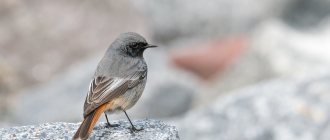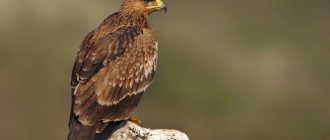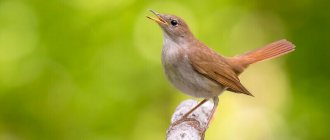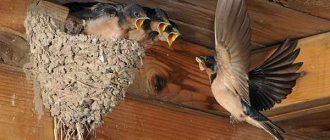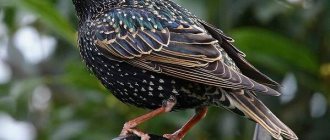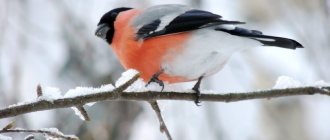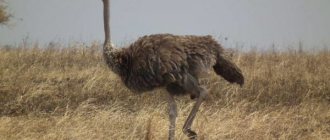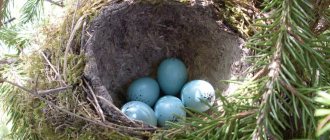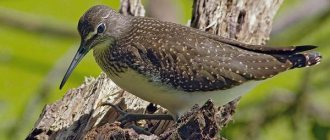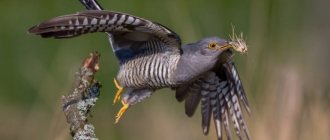Have you ever seen a bird wearing a blue apron? If yes, then you have met the inhabitant of our Russian expanses - the bluethroat bird. In fact, she was nicknamed differently for her remarkable appearance: blueneck, dawn, blue tit, bluebreast. And so - bluethroat - a bird in a blue “bib”.
Scientifically, the bluethroat is called Luscinia svecica, which means Swedish nightingale. This vocal bird was assigned by scientists to the order of passerines, the family of thrushes, and the genus of nightingales.
Why did the blue-breasted bird get the name bluethroat in Russian? It is believed that this “name” comes from the word “varakat”, that is, to chat in vain. So what happens - this bird likes to “talk”? Let's find out...
What does a bird look like wearing a blue bib?
This bird grows up to 15 centimeters in length. Males and females are almost the same size. Weight of males: from 15 to 23 grams, females: from 13 to 21 grams.
Bluethroat (lat. Luscinia svecica)
The color of the bird stands out due to the bright blue spot in the chest area and the red plumage in the uppertail area. But it is worth noting that this distinctive feature is characteristic only of male bluethroats. Females are colored quite inconspicuously. In males, the back is brown or grayish-brown in color. Female bluethroats in the chest and throat area are colored in light colors, the rest of the feathers are brown. The paws of bluethroats are dark in color and the beak is black and small in size.
Description and photo of the bluethroat bird
In the name of the bluethroat bird, it is correct to put the emphasis on the second syllable, that is, “browthroat”. The bluethroat is a bird that belongs to the order Passeriformes, the genus Nightingales and the flycatcher family. This is a fairly small bird, even smaller in size than a house sparrow. Its length does not exceed 15 cm, and its body weight is 15-23 g in males and 13-21 g in females.
Male and female bluethroats look different; the male has a brighter color. The back of the male bluethroat is gray-brown. The medium-length tail is orange with a brown tip. The male of this bird has a blue breast and crop with an orange or white spot in the middle. Also, at the bottom of the blue breast there is always a semicircular edging of black and then orange. The abdomen is light gray.
The female bluethroat's plumage is not so elegant. Her goiter has only a white spot and with a not very pronounced dark edging. Less commonly, there are small red spots on the chest. The back and chest are pockmarked, gray-brown in color, sometimes with dark patches. The tail is brown or brown-orange.
The paws and beak of male and female bluethroats are dark brown in color. In life or in a photo, a bluethroat is very easy to recognize by the description of its appearance, especially the male, because in birds a blue breast with orangish spots is not often found.
Like most small birds, the bluethroat feeds mainly on small insects and their larvae, which it catches on the ground or in vegetation. Also, her diet may include various berries, especially in the autumn.
The bluethroat bird has many subspecies that differ slightly in appearance, size and habitat. The lifespan of bluethroats is about 3 years.
Lifestyle and behavior in nature
Among their natural habitats, bluethroats prefer stream valleys, river openings, ravine slopes, and lake shores. The main condition for comfortable living is damp places covered with dense vegetation. In addition, bluethroats can be found in the forest-tundra zone and sparse forests. Birds build their nests on the ground.
The bluethroat is an elegant songbird.
Around mid-August, these birds begin to fly to warmer climes for the winter. It is worth noting that bluethroats are solitary birds. They even fly not in flocks, but one at a time. During seasonal migrations, the bluethroat does not fly too high from the surface of the earth, but is capable of covering a very long distance in a day - about 100 kilometers!
Where does the bluethroat live and where does it migrate?
The habitat of the bluethroat is quite wide. They live in Central and Northern Asia, in Northern Europe. The bluethroat lives almost throughout the entire territory of Russia. In winter it migrates to warm countries, since the bluethroat is a migratory bird. Winters in southern China, India, and North Africa.
The autumn migration of bluethroats, depending on the weather, can begin from mid-August to mid-September. When migrating, they fly low from the ground, flying from one tree or bush to another, and try to stick to various rivers and reservoirs. During migration, flocks are not collected and move alone, mainly at night. So the migratory flight of bluethroats cannot be called spectacular. This little bird can travel up to 100 km per day.
After wintering, bluethroats return from late May to early June. Males always return a little earlier than females. Immediately after returning, the marriage singing begins.
Bluethroats most often live near bodies of water (near rivers, streams and various lakes), and love thickets of bushes. They are found less often in forests, and they choose slightly dense areas overgrown with bushes.
What do blue-breasted birds eat?
The main food for the bluethroat is insects: ants, wasps, hornets and their larvae. All the winged six-legged cockroaches will certainly end up on the “dinner table” of the bluethroat bird.
Insects are the main food source for bluethroats.
In addition, the bird eats small mollusks, worms, and also eats a variety of berries.
Appearance of a bluethroat
Bluethroats are no larger in size than sparrows, but much slimmer and more elegant than these birds. They have a body length of 15 cm and a weight of about 15-20 grams. The elongated legs add grace to the form, and the bright colors of the males delight the observer. The bright shade of the feathers indicates that a male is sitting on the branch, preparing for the mating season. Females are distinguished by more modest colors, practically unchanged at different periods of life and seasons.
In domestic forests it is difficult to find an equally attractive and brightly colored bird, marked by refined grace. The most attractive part of the male's plumage is his blue shirtfront, bordered with brown and red stripes. In the center of the shirtfront there is a reddish spot, which is white in the western subspecies of birds. The outer tail feathers are also colored red. The red tail with the letter T of brown color is a distinctive feature of females and males, as well as young fledged chicks.
How bluethroats reproduce
The beginning of the mating season is marked by the loud cry of male bluethroats. Males, like nightingales, sing wondrous trills, attracting females to create a family nest. Males also show off their chest decoration, which is also one of the components of the mating ritual.
A bluethroat nest on the ground is very inconspicuous.
Having built a nest, the female bluethroat lays 4 to 7 eggs. The incubation period lasts about two weeks. After this period of time, small chatter birds are born. For about 13 days, the young generation sits in the nest, all this time the parents intensively feed the babies so that they grow up and get stronger as quickly as possible. Two weeks after birth, bluethroat chicks are already jumping out of the nest, although they do not yet know how to fly. They walk nearby with their parents and learn from them the basics of independent living.
Keeping bluethroats in captivity
Because of its beautiful color and melodic singing, the bluethroat is sometimes kept at home . These birds are placed in ordinary nightingale cages. They feed with mealworms or other larvae, grated grains and berries. It is imperative to have not only a drinking bowl with fresh water in the cage, but also a place for swimming, they love it.
If the bluethroat was picked up or purchased as a chick, then taming it will be very simple, but with an adult it will be more and more difficult. If the bird gets nervous and begins to fight in the cage, you should leave it alone. She must get used to the person and stop being afraid of him, and this will take time.
Don’t forget to subscribe to updates on our website and join us on social networks (Vkontakte, Odnoklassniki, Instagram) so you don’t miss anything and always stay up to date with all the news!
Don't forget to share with your friends!
Lifestyle
Small birds rarely catch the eye of the observer because they are nimble. The habitat is predominantly open meadow areas with a large number of water areas. Birds arrive from wintering in April, choosing places with overgrown willows, alders and sedges for nesting. The presence of water is a prerequisite for arranging a nest.
The males are the first to arrive at the site, occupying the selected territory for arranging the nest. The free area can be more than a hectare. Bluethroats are constancy, so they return to the same place where they built their nest the year before. They remember exactly where the nest was and occupy it again. Very often, couples reunite to breed, since males and females meet again in the same place after a year.
Birds are big fans of wet places, so their main habitats are lowlands near swamps, streams and rivers. There is always tall and lush vegetation, which blue-breasted singers love. In addition to thickets of trees, bluethroats can make nests in tall grass, on the branches of bushes or in dense meadows.
Of the same blood as nightingales
Bluethroats belong to the genus Luscinia, which makes them similar to nightingales. Like these famous singers, they are able to copy elements of trills from other birds. Often hearing masterly singing in dense thickets, not everyone is able to realize that it is a small bird with a blue breast that is singing. In the whimsical tints one can hear the trills of sandpipers, warblers, magpies and even the strumming of a guitar. In any, even the most complex melody, there is a characteristic wa-rak, for which the bird received its unusual name.
Although the songs of bluethroats are not as varied and virtuosic as those of their famous relatives, they do not leave any listener indifferent. Like nightingales, each bird has its own repertoire, differing in melody, tonality, number of transitions and manner of constructing a trill.

